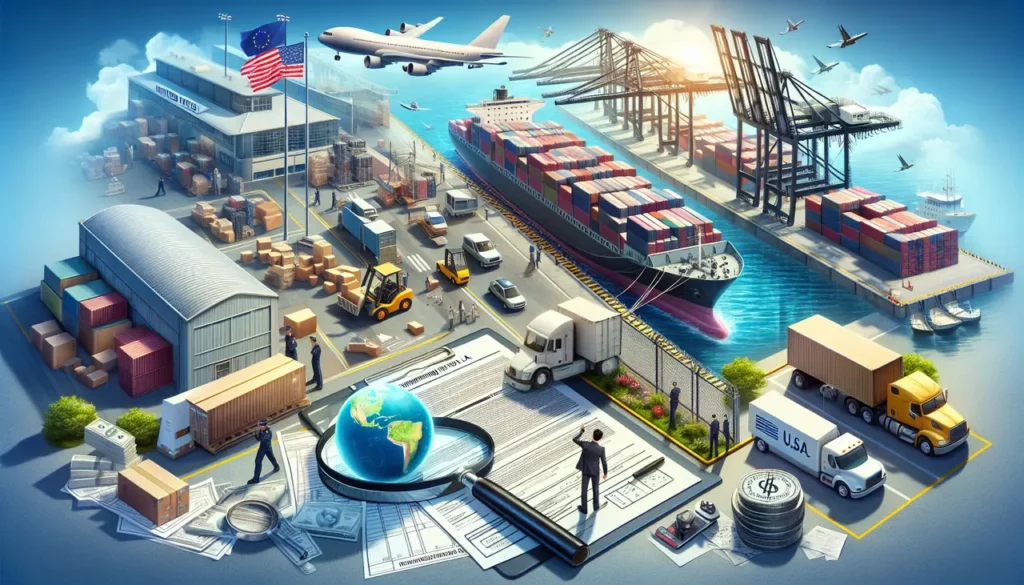Introduction to Importing Goods into the U.S.A.
Importing goods into the U.S.A. sounds daunting, right? But hey, it’s far from impossible. First things first, know this – the U.S. is a land brimming with opportunities for businesses eager to expand. Whether you’re eyeing to bring in electronics, fashion apparels, or any other product under the sun, understanding the basics can set you on the right path. So, where do you start? By grasping that yes, rules are plenty, but they are there to guide you, not scare you away. The U.S. Customs and Border Protection (CBP) is your new best friend. They call the shots on what gets in and what stays out. And here’s a golden nugget – not all products are treated equally. Some might need a special permit or undergo strict regulations due to safety or health concerns. But remember, no mountain is too high. With the right knowledge and preparation, importing into the U.S. can be smoother than you think. Ready to embark on this journey? Let’s roll up our sleeves and dive in deeper in the next sections.

Understanding the Legal Requirements for Importing
When importing goods into the U.S.A., getting tangled in the complex web of legal requirements is easy. But don’t worry; let’s break it down simply. First off, you need to know that U.S. Customs and Border Protection (CBP) is the main watchdog at the gates. They’re the ones checking if everything’s in order with your goods. So, first things first, get acquainted with the CBP’s rules—it’s non-negotiable.
One major rule is you have to declare your items. That means telling CBP exactly what you’re bringing into the country, no matter how small or big. If you’re a business, you’ll likely need an Importer Number, a unique identifier for your transactions. This is usually your IRS business registration number. No IRS number? No sweat. Your Social Security Number can work in a pinch.
Another key point is checking if your goods need a special permit. Items like food, plants, and some electronics often need a nod from specific federal agencies before making their journey into the U.S. Ignoring this can lead to your goods being held up or, worse, confiscated.
Also, brace yourself for duties and tariffs. These are essentially taxes on the items you’re importing. The rate can vary wildly depending on what you’re bringing in. Some items might slide in duty-free, thanks to trade agreements, while others can have a hefty tariff. To find out what you’ll owe, dive into the Harmonized Tariff Schedule. It might look daunting, but it tells you exactly what tariff rate applies to your items.
Lastly, paperwork. It’s dull but crucial. You’ll need to fill out a Customs Entry form which is a declaration of the type, value, and quantity of goods you’re importing. Mess this up, and you could face delays or penalties.
In summary, have your paperwork tight, know what you owe in terms of duties and tariffs, ensure you have the necessary permits, and remember
Identifying the Best Goods to Import
When looking to import goods into the U.S., choosing the right products is key. Start by researching what sells well and what’s in demand. Think gadgets, fashion, eco-friendly products, or anything that solves a problem. Yet, it’s not just about what’s hot. Consider the competition. Less competition means a bigger slice of the pie for you. Check out trade shows, online forums, and market trends for ideas. Also, focus on quality and uniqueness. Products that stand out or offer something special have a better chance of success. Remember, picking what to import is a mix of spotting trends, understanding demand, and finding your niche. Go for products that you’re passionate about and have a solid market—you’ll be setting yourself up for a win.
How to Find Reliable Suppliers Overseas
Finding reliable suppliers overseas plays a crucial part in importing goods to the U.S. Start by doing your homework. Look into online directories like Alibaba and Global Sources. These platforms connect you with suppliers around the world. But, here’s the thing, don’t take everything at face value. Check reviews and feedback from other customers. It’s like detective work; you’re looking for clues to make sure they’re legit. Next, hit up trade shows. It’s old school but effective. Trade shows give you the chance to meet suppliers face to face, see the products firsthand, and ask all the questions you have. It’s about building a relationship. You’re not just sending emails; you’re shaking hands. Lastly, consider hiring a sourcing agent. These are professionals who can do the heavy lifting for you. They know the local markets, speak the language, and most importantly, they can help you avoid scams. Remember, it’s all about trust. If something feels off, it probably is. Take your time, do the legwork, and you’ll find suppliers that not only meet but exceed your expectations.
The Role of Customs and Border Protection (CBP)
When you’re importing goods into the U.S., the Customs and Border Protection (CBP) is your main checkpoint. Think of them as the gatekeepers. Their job is to make sure everything entering the country follows U.S. laws and regulations. What does this mean for you? First, your goods get reviewed by the CBP. They check if your items match the information you’ve provided and ensure everything’s legal and safe to enter the U.S. If something’s off, your goods might not make it through. Also, the CBP calculates duties and taxes on your imports. The amount you’ll pay depends on what you’re bringing in and its value. Getting through customs smoothly means having all your paperwork in order, like bills of lading and invoices, and being ready to pay any required duties and taxes. Remember, honesty and preparation are key when dealing with the CBP. They’re not just there as a hurdle; they help protect the country’s economic health and safety.
Documentation Needed for Importing Goods
When importing goods into the U.S., the paperwork might seem daunting, but it’s pretty straightforward once you get the hang of it. First off, you’ll need a Bill of Lading. Think of it as the official list of what you’re shipping. Then, there’s a Commercial Invoice. This is crucial; it tells Customs what you’re bringing in and how much it’s worth. Don’t forget the Packing List. It details everything in the shipment, making checks easier. You also need to show a Certificate of Origin. This confirms where your goods were made. If your items are under protection, like patents, you’ll need the Arrival Notice from the carrier. Lastly, specific goods require special documents, like a license or permit, depending on what you’re importing. Stay organized, and you’ll navigate through the paperwork maze easily.
Calculating Taxes, Duties, and Other Import Fees
When bringing goods into the U.S., you must brace yourself for additional costs beyond the price tag. Think of taxes, duties, and various fees as the gatekeepers to the U.S. market. The Harmonized Tariff Schedule of the United States (HTSUS) is your bible here. It decides the rate of duty for your imported goods. Sometimes, figuring this out feels like decoding a secret language. But, here’s the kicker – most commercial goods entering the U.S. are subject to import duties. The exact amount? That depends on the type of goods and their country of origin. Countries with a trade agreement with the U.S. might enjoy lower duty rates. Don’t forget about taxes. Sales tax isn’t a big player in international shipping, but other taxes might apply, based on the state.
And then we have the brokerage fees. If you’ve decided to use a customs broker to help navigate the choppy waters of U.S. customs, their services aren’t free. These fees vary widely, so shop around for a good deal. Electronic filing fees, merchandise processing fees, and harbor maintenance fees can also nudge your total cost higher. Each fee might seem small, but together, they add up.
In a nutshell, calculating your total import costs is more art than science. You’ve got your base cost (the price of the goods), plus shipping, insurance, duties, taxes, and brokerage fees. Miss one, and your budget might go off the rails. So, grab that HTSUS, do your homework, and maybe, just maybe, you won’t be caught off-guard by the costs.
The Importance of Hiring a Customs Broker
Hiring a customs broker is like finding a guide in the wild. These folks know the ins and outs of importing goods into the U.S.A., a process that might seem like a maze to many. Why bother with a customs broker? For starters, they’re experts in navigating the complex regulations and paperwork needed to get your goods through customs smoothly. They keep up-to-date with ever-changing laws and tariffs, making sure you don’t hit any unexpected snags or penalties. Think of them as your personal GPS through the import process, saving you time, money, and a good deal of stress. Sure, it’s an added cost, but consider it an investment towards hassle-free importing. Plus, for businesses looking to expand their import operations, a reliable customs broker is invaluable in avoiding costly mistakes. In short, if you’re serious about importing goods into the U.S.A., getting a customs broker on your team is a smart move.
Navigating Trade Agreements and Exemptions
Understanding trade agreements is crucial when importing goods into the U.S.A. These agreements can make your process smoother and sometimes cheaper. The U.S. has agreements with several countries, meaning goods from these places can come in with lower tariffs or none at all. It’s all about where your goods originate. For instance, goods from countries with which the U.S. has a Free Trade Agreement (FTA), like Canada under USMCA (formerly NAFTA), might have no tariffs. This can significantly reduce your costs.
Next, don’t overlook exemptions. Some goods might not need to pay certain duties under specific conditions. For example, if you’re importing items in small quantities or samples for trade shows, they might be exempt. It’s about the details. Always check the latest rules because these exemptions can change. Ultimately, knowing about these trade agreements and exemptions can save you money and hassle. Stay informed, and always double-check your goods’ eligibility for a smoother import process.
Final Checklist Before Importing Goods into the U.S.A.
Before you bring your goods into the U.S.A., there’s a final checklist you need to run through. This is your last line of defense to ensure everything is in order, so pay close attention. First, double-check that all your paperwork is spot on. This includes your Bill of Lading, Commercial Invoice, and any other documents specific to your goods like permits or certificates. Incorrect paperwork can delay your shipment or incur extra fees, and you don’t want that. Ensure your goods comply with U.S. standards and regulations. This is crucial. The U.S. has strict rules on what can and can’t be imported, covering everything from safety standards to environmental regulations. If your goods don’t comply, they won’t make it past customs. Also, confirm all your duties and taxes are calculated correctly. Misunderstandings here can be costly. Use the Harmonized Tariff Schedule to determine the exact duties applicable to your goods. Lastly, have a clear plan for customs clearance. Decide whether you’ll handle it yourself or hire a customs broker. If you’re unsure, leaning on the expertise of a broker can smooth the process. Remember, this final checklist is your safeguard against delays and extra costs. Give it the attention it deserves.

